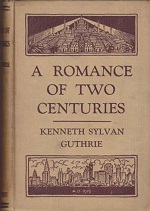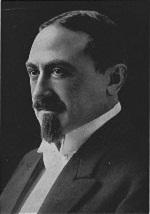|  | | | | 

| | A Romance of Two Centuries:
A Tale of the Year 2025
by Kenneth Sylvan Guthrie
First publication: 1919

  |
After being given sleeping sickness by the Germans in The Great War, our hero is taken back to America by a kindly nurse and put into a deeper sleep, only to awoken in the year 2025 where he is renamed Oleander Parentive Neurodundeeian, falls in love, and experiences the generally amazing future. But that’s not where the time travel comes into play (that’s merely falling into a long sleep). The backward time travel occurs when he wants to relate all this back to his wife and companions in the early 20th century. As for the mechanism for achieving this, only Guthrie’s original words in the following quote can do it justice: Jules Verne, in his Tour Around the World in Eighty Days, had made the plot hinge on the fact that by circling the entire globe Mr. Fogg had gained one day. I also called to mind how, when European newspaper correspondents telegraphed to America, the message reached there five hours before it was sent. A childishly simple calculation showed that if a telegraph message was made to circle the whole globe, it would arrive twenty-four hours, or one calendar day, before it was sent. If then it were possible to telegraph twice around the globe, it would arrive two days before it was sent, and so on in proportion. If a message circled the globe 365 times, it would arrive one full year before it was despatched. 3650 times would anticipate 10 years, and 36,500 times would gain 100 years; and as to reach my wife of long ago I needed to go back 110 years, the problem would be solved if I could send a message around the globe 40,150 times without stopping. Of course, there would be a rectification to be made for the 27 leap years, so that the needed circlings would be 40,177. Jules Verne, in his Tour Around the World in Eighty Days, had made the plot hinge on the fact that by circling the entire globe Mr. Fogg had gained one day. I also called to mind how, when European newspaper correspondents telegraphed to America, the message reached there five hours before it was sent. A childishly simple calculation showed that if a telegraph message was made to circle the whole globe, it would arrive twenty-four hours, or one calendar day, before it was sent. If then it were possible to telegraph twice around the globe, it would arrive two days before it was sent, and so on in proportion. If a message circled the globe 365 times, it would arrive one full year before it was despatched. 3650 times would anticipate 10 years, and 36,500 times would gain 100 years; and as to reach my wife of long ago I needed to go back 110 years, the problem would be solved if I could send a message around the globe 40,150 times without stopping. Of course, there would be a rectification to be made for the 27 leap years, so that the needed circlings would be 40,177. 
| |
| | | | |

 
No Time Travel. Move along. |
“The Man Who Met Himself” by Donovan Bayley, The Thrill Book, Mar 1919 [despite title, no time travel ]

| |     |